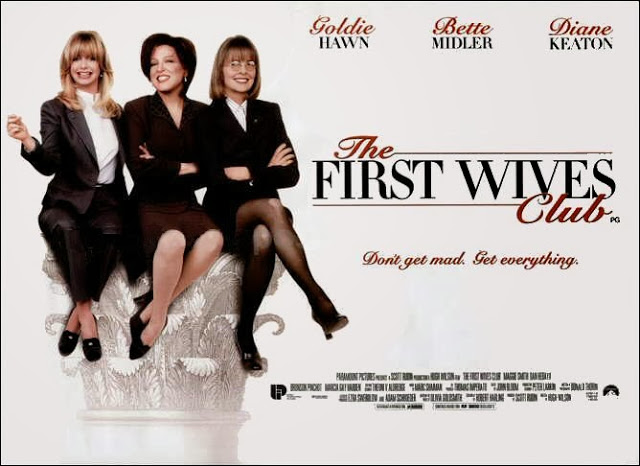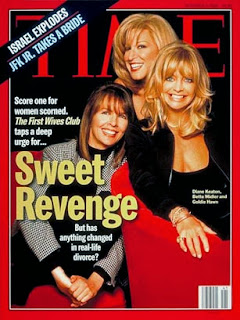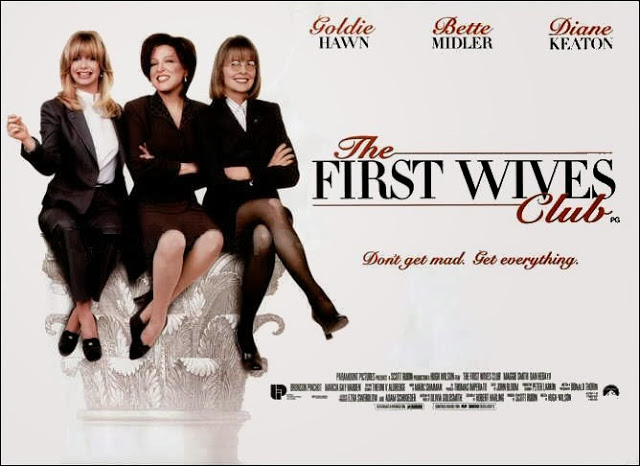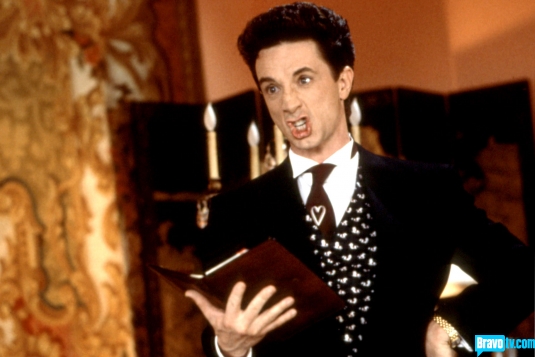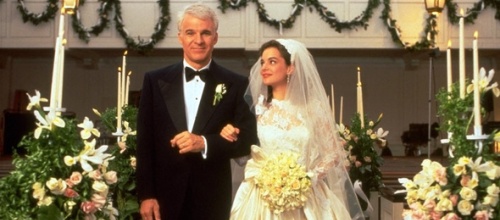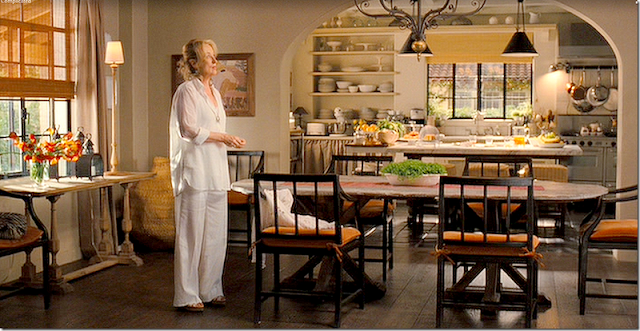This guest post by Artemis Linhart appears as part of our theme week on Female Friendship.
This made-by-men film navigates female friendships through the proverbial battle of the sexes, steering clear of “a feminist manifesto,” unleashing just what it deems feasible. This is the premise, which sounds much worse than it turns out to be.
Three mid-40s women whose husbands have left them for younger women decide it’s time to opt out of misery and take matters into their own hands. Thus forms the First Wives Club. Assembling Goldie Hawn, Bette Midler, and Diane Keaton makes for a true 90s Dream Team of female energy. Who wouldn’t want to be a member of a club like that?
The main characters’ friendship goes way back: a flashback shows the group in college, together with their valedictorian and close friend Cynthia. The four of them vow to be friends forever. This, however, turns out to be easier said than done. After graduation, the four of them lose touch and are only reunited years later, with the occasion being Cynthia’s funeral. After her husband took financial advantage of her and then left her for a younger woman, she commits suicide. At a post-funeral get-together, the three women bond over their own failed marriages and spite for their ex-husbands. Their friendship is rekindled as they decide to settle the score with their exploitative exes.
While a desire for revenge starts out to be the foundation of The Club, the driving force behind it soon proves to be the substantial companionship the three of them share.
When it doesn’t all pan out at first, a feud arises that splits the trio up temporarily. They lash out at each other in a way only close friends can and reconcile accordingly. The big fight is overcome and it is emphasized that there are more important things than silly catfights – specifically friendship and, in their case, the pressing issues at hand.
There is a lesson to be learned here – one that transcends the supposed target audience of the middle-aged woman, as well as the decades, and connects with more recent cinematic works focusing on female relationships. In order to end the notorious “Mean Girls” spirit, there needs to be a shift in perspective – starting with an awareness of the significance of establishing and maintaining support among females. By vanquishing the damaging representation of the “Girl vs. Girl” trope, The First Wives Club is a good example of teaching adolescents the values of female solidarity, which, in turn, is an important pillar of everyday feminism.
However, the key demographic of the film is not to be disparaged. Amidst the rather ageist “Girl Power”-craze of the 90s, it focuses on one of the movie industry’s lesser-discussed subjects. This is addressed directly in a self-referencing statement made by Goldie Hawn’s character: “There are only three ages for women in Hollywood: Babe, District Attorney and Driving Miss Daisy.” The film itself makes room for this overlooked, often excluded group of people and places it in a feminist context.
Triumphant Triumvirate
As the First Wives Club takes shape, the three women rise to the occasion and take on the challenge full-scale. This allows for the power dynamics of the group to shift and become more balanced. Annie (Diane Keaton) leaves her old pushover-self behind and takes charge. Elise (Goldie Hawn) gets off her high horse and Brenda (Bette Midler) gains more confidence in the face of her ex-husband’s new fiancée (satirized aptly by Sarah Jessica Parker, who rode her broomstick alongside Bette Midler just three years prior in Hocus Pocus, a female friendship tale of the witchy kind).
Owing to their new-and-improved friendship, they each gain strength and build each other up along the way. What follows is a buoyant heist show with slapstick galore – all of this against the backdrop of the good cause, the big picture, the women power. Indeed, they have the full support of one of New York’s society grande dames (Maggie Smith), who, too, was once a first wife (as well as a second, third, and fourth). Unconditional support also comes from Annie’s Daughter and Brenda’s boss, as well as a handful of cameos by the likes of Gloria Steinem and Ivana Trump.
After settling their own issues, they proceed to step it up a notch and help other women in need. As they found the Cynthia Swann Griffin Crisis Center for Women, the trio truly rises to the top – of society, the media, and the moral code – their (granted, naïve) objective being that no woman will have to suffer the same fate as their friend Cynthia.
Based on a novel by Olivia Goldsmith, this film is written, directed and produced by men. Whereas in the movie there are certainly a few problems with the representation of women and their actions, they seem less grave without direct comparison to the book. In view of the film version being constructed as a lighthearted comedy, there are a few content-related details worth mentioning.
The general tone of the much more progressive novel is darker and more serious. Here, the punishment for the ex-husbands is more brutal, while the female characters are portrayed as multi-dimensional – as opposed to their cinematic depiction, which is shrill, occasionally hysterical and lacks depth. Especially the roles of the new girlfriends are particularly cardboard in Hugh Wilson’s version.
In contrast to the film, the story is about more than revenge – it focuses on empowerment and actively addresses the notion that women should not feel afraid to be labelled as having strong opinions and personalities.
As one might expect, the film is considerably more hesitant concerning feminist representations. To sidestep a too “radical” stance that was perhaps misconstrued as “male-bashing,” a “light”-version of Olivia Goldsmith’s original ideas was created – often in questionable ways. The filmmakers’ way of redeeming the image of the “man-hating beasts,” for example, was the decision to reunite Brenda with her ex-husband. This seems like a cowardly quick fix that goes against everything the First Wives Club stands for, especially considering the fact that in the novel Brenda’s new partner is a woman.
And yet, while it may not be as groundbreaking as the book, the movie could be a great deal more disastrous. It is pro-emancipation without too much of an “anti-men” vibe. Interestingly enough, the title of the German version translates to “The Club of the She-Devils” – a crude demonstration of an obnoxiously archaic perspective on the film.
Retaliation in Style and in Rhythm
While the trio’s friendship seems to be based largely on achievement and a distinct goal respectively, there is, nonetheless, a perpetual sense of a true and meaningful connection. Merely by the way they interact with each other, it is palpable that there is still a lasting bond between them. There is, indeed, an air of the blithe BFF sentiment from back in their college days. Correspondingly, both Cynthia and Annie still keep a framed picture of the four of them in their homes.
Another symbolic marker of their friendship is Leslie Gore’s hit song “You Don’t Own Me,” their college-times performance of which they reminisce about and even repeat twice in the film. This song is truly a great pick and shows that the filmmakers were not too afraid to use a clearly feminist song. As a recurring theme, their own rendition of the sixties classic can be seen as a symbol of their lasting friendship as well as their newfound empowerment. It culminates in the very last scene of the movie as they sing and dance off into freedom. The happiest of endings: not primarily a romantic one, it celebrates the courage, independence and companionship of the three women.
Another important factor that comes into play is the way in which the women handle their respective husband’s new relationship status. While they harbor anything but positive feelings for the mistresses they have been left for, instead of blaming the “other woman” for the man cheating – as seems to be common practice among women on and off screen – they focus their anger and revenge on the men. They do this in a dignified manner, true to the tagline of the film: “Don’t get mad. Get everything.”







